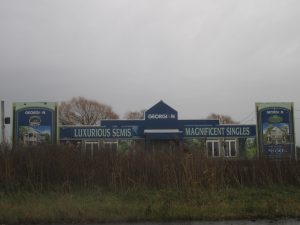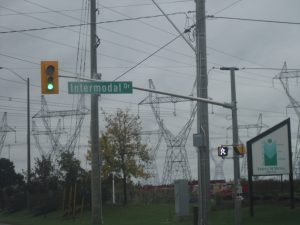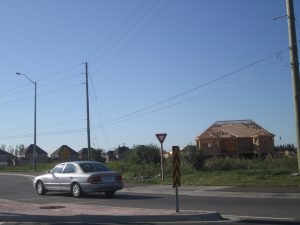By Roger Keil
Cities in waiting are evident along Highway 427 and Highway 7 in the northwest of Toronto. Going and coming. Mississauga. Vaughan. Brampton, Ontario. It is clear that something very rapid is gestating here. The suburban development we see around the northern reaches of Canada’s largest city is moving faster, and in more diverse fashion than anything of the sort in the past. The bulge is urban. It is really more like those developments we associate with cities. It is the Expectant City, the emerging landscape of the Greater Toronto Area.
The sheer numbers are almost beside the point. They speak of a turning tide as the inner city, despite its frantic condofication, cannot ever again catch up with its outer rim. Between 2001 and 2006, the central municipality of Toronto grew by a mere 1 percent, while its surrounding regions sprawled by 22.4% (York), 17.2% (Peel) and 17.1% (Halton). There are now 2.7 million people in the municipality of Toronto and more than 3 million people in the area around them. The boom in people and economic activity that we call suburbanization is not emergent in the sense of an organically driven process as proposed by some newer libertarian theories. It is guided by governance through tightly regulated markets and prescriptive government.1 In this particular space, large development corporations and municipal administrations cooperate to meet the demands of a provincial framework that defines planning as a game towards producing “places to grow”. There is no such thing as unplanned urban sprawl.
The story on the ground tells of dramatic change, a story with many actors. Visually, it is hard to digest on a mere drive by. Brampton Dental Arts offer their services from a wooden makeshift billboard in open fields as if cavities stemming from big box processed, corn sweetened food was already working its way into the teeth of the suburbanites before they have moved in. Smart Centers are always there. You cannot miss them. They own this landscape as John Lorinc has described so well and they are allegedly beginning to turn the malls they know to build into the city centres that suburbia is anxious to have. Meanwhile, brokers such as Colliers Real Estate lie in waiting, as construction containers are placed strategically at intersections, not far from the “Green Park Star Lane Sales Centers”. Also, Paramjit Birdi wants part of the action while “Luxurious Semis” and “magnificent singles” await construction.
The city in waiting is the domain of multiple speeds: la ville a vitesses multiples. Yet the time space compressions of the inner city (the scrambles and layerings) here are splintered still into competing modes where automobility reigns supreme and the pedestrians and cyclists as well as the transit buses hurry along uncertain yet of their role in the landscape. This will eventually change. The layout is there. The tracks of rapid transit will surely be built. Right now, pedestrians hurry, bent in the frigid wind, as they leave the futurist bus shelter, along the six-lane highway, beyond the commercial strip into the safe zone of the lone condo tower or the monster home behind. It cannot and will not stay that way. The city in waiting will grow into itself. But who has time to wait?
 While it produces a radical periphery with new scales, speeds, sequestered sensoria, the city in waiting is also about new centralities. There is always this dialectic. As is the case in Kitchener-Waterloo, as detected by the pioneering work of Markus Moos and his fellow researchers: While suburbanization is evident, there is also the centrality of power and institutions, not necessarily in the cores of the old towns, though. Undeterred, Mississauga, Brampton and Vaughan2 are rushing to build themselves town centres. Some of these moves are transit-related, in hope or expectation of future mobility advantages. Writes Lorinc about Vaughan: "The suburban City of Vaughan wants that terminal station to become the hub of a new high-density, pedestrian-friendly downtown, served by not just the subway but also by the regional commuter bus service. Thus, [Smart Centres owner] Goldhar now finds himself in the unfamiliar role of city-builder. 'Clearly there’s the infrastructure to do something much more dense than single-storey at grade,' he says. Besides lining up tenants for that new office building, he’s down in the trenches, negotiating with municipal officials about relocating the Walmart and building a bus station. And his many critics might be surprised to learn that he’s recruited prominent Toronto architect and urbanist Don Schmitt to draw up a master plan that envisions 16 million square feet of development over at least 15 years, including office buildings, condos, public open spaces, schools and, of course, retail. 'It’s not going to be a shopping centre,' muses Goldhar, his imagination fired by the prospect of developing something more ambitious, and more enduring, than just boxes surrounded by asphalt. 'It’s going to be a city centre.'” Vaughan’s neighbour Markham to the West has explicit ambitions. It is often considered “ahead of the curve” not just of their suburban counterparts but also of the Growth Plan itself. A group at the Institute Without Boundaries at George Brown College studies the suburban town’s potential to move “from edge city to complete city”. This may be a tall order now but the structures are already inscribed into the landscape.
While it produces a radical periphery with new scales, speeds, sequestered sensoria, the city in waiting is also about new centralities. There is always this dialectic. As is the case in Kitchener-Waterloo, as detected by the pioneering work of Markus Moos and his fellow researchers: While suburbanization is evident, there is also the centrality of power and institutions, not necessarily in the cores of the old towns, though. Undeterred, Mississauga, Brampton and Vaughan2 are rushing to build themselves town centres. Some of these moves are transit-related, in hope or expectation of future mobility advantages. Writes Lorinc about Vaughan: "The suburban City of Vaughan wants that terminal station to become the hub of a new high-density, pedestrian-friendly downtown, served by not just the subway but also by the regional commuter bus service. Thus, [Smart Centres owner] Goldhar now finds himself in the unfamiliar role of city-builder. 'Clearly there’s the infrastructure to do something much more dense than single-storey at grade,' he says. Besides lining up tenants for that new office building, he’s down in the trenches, negotiating with municipal officials about relocating the Walmart and building a bus station. And his many critics might be surprised to learn that he’s recruited prominent Toronto architect and urbanist Don Schmitt to draw up a master plan that envisions 16 million square feet of development over at least 15 years, including office buildings, condos, public open spaces, schools and, of course, retail. 'It’s not going to be a shopping centre,' muses Goldhar, his imagination fired by the prospect of developing something more ambitious, and more enduring, than just boxes surrounded by asphalt. 'It’s going to be a city centre.'” Vaughan’s neighbour Markham to the West has explicit ambitions. It is often considered “ahead of the curve” not just of their suburban counterparts but also of the Growth Plan itself. A group at the Institute Without Boundaries at George Brown College studies the suburban town’s potential to move “from edge city to complete city”. This may be a tall order now but the structures are already inscribed into the landscape.
The city in waiting is a full frontal challenge to the perceived, conceived and lived space of the urban region as it constantly pushes up against the notions of closure, centripetality and planning reason. The city in waiting explodes the scale of what we believe to be the urban region in more ways than one. We know about the airport in the middle of the (sub)urbanizing landscape. We have heard about foodlands paved by sprawl. We certainly realize that for most of us, the centre of the region has long moved to somewhere between Steeles Avenue and Rutherford Road. As a megaquarry is being planned for the land way beyond the sunset along Highway 7, it is exurbanites who lead the struggle against the mining and transport of aggregate so central to the fulfillment of the dream of the city in waiting. The politics of the emergent urban sensorium has already jumped the scale of the watershed, the airshed, the commutershed and is now encamped in the gravelshed newly defined by plans to dig up a hole the size of several High Parks for the building of condos, roads and bridges in the GTA.
For now, much of what we see along those highways is an automobile dreamscape (although those dreams are often interrupted by miles of wagons on trains that cut through the winter landscape). And it is by no means all residential. Quite to the contrary. There are fields that are being graded for another one million square feet of warehouse or production facility here or there. There is actually a street called Intermodal Drive north of Malton that says it all. It is where Canadian Tire resides and if that disappeared, there would be no presents in the houses of the holy downtowners this Christmas, no spring cleaning in the Annex, no summer gardening in the Beaches and no rakes for the leaves of Riverdale in autumn.
 Part of the emergent character of the outer city is that it is not going to be a refuge for anyone trying to leave the “messiness” of the city behind. This is not true for socioeconomics, as diversity in income is beginning to be a reality in formerly more wealthy areas. Ethnocultural diversity is now becoming the norm in Canadian and even in American suburbs (where one speaks of desegregation through suburbanization now) In Canada, the suburbs are the new port of entry as families and communities of newcomers cluster along ethnocultural and class lines in the new subdivisions and tower neighbourhoods of the city in waiting. It is from this outside in that they have begun to redefine the meaning of (sub)urbanity.
Part of the emergent character of the outer city is that it is not going to be a refuge for anyone trying to leave the “messiness” of the city behind. This is not true for socioeconomics, as diversity in income is beginning to be a reality in formerly more wealthy areas. Ethnocultural diversity is now becoming the norm in Canadian and even in American suburbs (where one speaks of desegregation through suburbanization now) In Canada, the suburbs are the new port of entry as families and communities of newcomers cluster along ethnocultural and class lines in the new subdivisions and tower neighbourhoods of the city in waiting. It is from this outside in that they have begun to redefine the meaning of (sub)urbanity.
There will be politics in the city in waiting. The conversation has begun. While conservatives have attempted to hijack the formation of genuinely novel political discourse through the rhetoric of opportunity, development and social conservatism there is now also a new progressive set of voices joining the chorus in the city in waiting. Now, already, as Myer Siemiatycki has found in a recent report, the outer cities are doing better than the inner city in minority representation in municipal councils. Moreover, at the federal and provincial level, younger progressive visible minority politicians like 29-year-old Tamil Rathika Sitsabaiesan, elected last in May 2011 for the social democrat New Democratic Party in the suburban riding of Scarborough-Rouge River, are changing the game. Likewise, 32 year old Jagmeet Singh took the seat for the provincial NDP in the Bramalea-Gore-Malton riding of North Mississauga. In any case, the debate has now begun as to whether suburbanization naturally tends to lead to a ‘clubbisation’, privatization and commercialization of political space (leading to new forms of exclusion and segregation) or whether there is a more “differentiated social dynamics” at work. Most importantly, this debate now is not entirely structured by the desires of inner city voices trying to hedge in the exotic suburban. A new dynamic has begun to take shape. As Navneet Alang has recently argued in a pointed piece that the monopoly of the “white scenester” over the interpretation, of what the city in waiting may have in store, has been challenged and broken. He writes: “there’s a lot more going on [in] the suburbs than most downtowners seem to think. Rob Ford’s ward of North Etobicoke, for example, is a veritable hotbed of cultural hybridity and complexity. There is, to misappropriate Gertrude Stein, very much a there there. But more than anything, the suburbs are full of people who are getting a bit sick of being told that the dream they’ve worked so long and hard to realize is somehow a mistake or an aberration, ideas that only get more unsettling when spouted by privileged, white people. And if we are to move to a sustainable, populist version of urbanism that is truly multicultural and Canadian, then we are going to have to learn to appreciate and adapt to the cultural gaps that we not only now ignore, but deride and denigrate”. David Kolb, in an interesting new essay, speaks about the emergence of a “polycentric habitus” that has taken hold in suburbanized urban regions. With ultimately a much different agenda than Alang (Kolb is interested in network politics and the dystopian aspects of digital space that stand for connectivity in the post-central age) but his points resonates with the core of this post: “A graph showing a person’s or a town’s connections would now be less like a tree opening out from a central node that must be traversed to reach other regions. Relations can spread and link without passing through hierarchically dominant Centers.” In quite similar spirit, Andy Merrifield has recently riffed on Lefebvre’s Right to the City and has brought into play the politics of “everybuddy” in a yet to be determined new global landscape of urban politics: “But what kind of human—rather than urban—space will this be, and what kind of new social networks hold the key for a 21st-century politics of militant democracy?” These are by no means the last words in an emergent debate. But they constitute a good starting point from which to begin rewriting the rules of hegemony that have governed the city in waiting in the past.
Notes:
1 Ekers, M., Pierre Hamel, Roger Keil, Governing Suburbia: Modalities and Mechanisms of Suburban Governance, Regional Studies, forthcoming [paper can be obtained from rkeil@yorku.ca]
2 Tracy Hanes, Vaughan: A Place to Grow, The Toronto Star, Section H1, Saturday, October 22, 2011.
Next: In my next blog, I will deal with who’s winning: the city or the suburbs. And why the way the question is usually being asked leads nowhere. Stay tuned.



4 comments on “Cities in waiting”